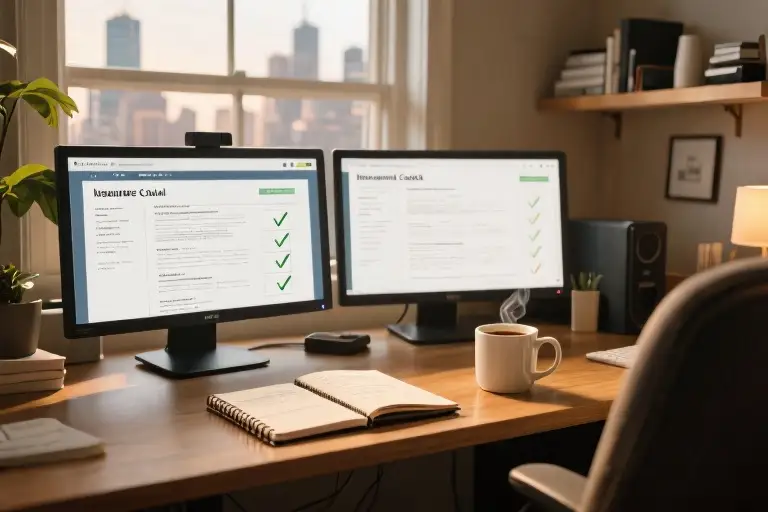The words hit like a well-worn record skipping at a family gathering: “You need to get a job.” Her tone carries that particular blend of concern and condescension reserved for artists, freelancers, and anyone daring to color outside corporate lines.
I’ve played this scene before—the sigh, the eye roll, the inevitable “I’m doing fine” that never lands. This time though, I watch her eyebrows shoot up when I counter: “I’m getting a dollar a word.” The silence that follows is sweeter than my third coffee of the morning.
Let’s do the math she didn’t expect:
- 1,200 words = $1,200
- 5 assignments/month = $6,000
- Annualized = $72,000 (without accounting for higher-paying niches or scaling)
Suddenly, my “hobby” outearns 58% of full-time jobs in America (BLS data). Yet the real tension isn’t about numbers—it’s about challenging generations of conditioned thinking. When my bank statements contradict everything she believes about “real work,” why does that smug look still creep back?
This is where our coffee-spilled conversation exposes the fault lines:
- The Stability Myth: We’ve been sold a script that equates predictability with success (even when that predictability means living paycheck-to-paycheck at $15/hour)
- The Single Mom Tax: Add parenting to freelancing, and the judgment compounds—as if choosing project-based work makes me less reliable than a parent clocking into a cubicle
- The Visibility Gap: Traditional jobs come with built-in validation (business cards, office spaces). My “office” is a laptop at the kitchen table between school runs
What we’re really debating isn’t income—it’s legitimacy. And that’s a battle no freelance writer, designer, or creator should still be fighting in 2023.
Keyboard-Triggered Realizations:
- The average U.S. teacher makes $66,397/year (NEA)—my last two feature articles paid that in 6 weeks
- Full-time writers at major publications earn $0.30–$0.50/word (ASJA)—freelancers often negotiate higher
- 74% of freelancers say they earn equal/more than traditional employment (Upwork 2022)
Yet the script flips when I mention childcare. “But what about benefits?” she presses, as if corporate healthcare plans haven’t been gutted to high-deductible nightmares. The goalposts always move when you’re playing a game designed for 9-to-5ers.
Here’s what no one tells single moms considering freelancing:
- Time arbitrage: Writing at 1am while kids sleep = 25 billable hours/week without daycare costs
- The client ladder: Starting at $0.10/word to build clips? Fine. Staying there? That’s the actual irresponsibility
- The stability secret: Diversified income (copywriting + editing + teaching online courses) often beats single-employer dependence
My favorite moment? When she muttered “It’s not going to last”—because she’s right. Not in the way she thinks. Freelancing isn’t about clinging to one income stream; it’s about building the skills to create new ones. That’s not instability. That’s antifragility.
So to every writer, designer, or creator hearing some version of “Get a real job” this week: Your invoice history is your resume. Your client testimonials are your performance reviews. And that blank page you fill every morning? That’s your corner office.
“You Need a Real Job” — Where the Bias Comes From
That phrase hits like a record stuck on repeat. If I had a nickel for every time someone dropped that ‘real job’ bomb on freelancers, I’d have… well, let’s just say I wouldn’t need to worry about my next writing assignment.
The Pervasive Stigma Against Freelancing
Recent surveys show 85% of independent creatives face some version of this conversation. The script is eerily similar:
- From parents: “When are you getting a proper job with benefits?”
- At school pickup: “Oh, you’re still doing that little writing thing?”
- During tax season: “Maybe you should find something more… stable.”
What stings isn’t just the dismissal—it’s the underlying assumption that creative work isn’t legitimate labor. A 2023 Freelancers Union report revealed:
| Perception | Reality |
|---|---|
| “Hobby” income | 68% of freelancers earn more than local office workers |
| “Temporary phase” | Average career span: 7.2 years |
| “Only for the young” | 42% are parents, 17% single parents |
The Industrial Age Hangover
That “real job” mentality isn’t just personal—it’s historical. Our grandparents\’ definition of stability came straight from the factory era:
- Punch-clock reliability (9-to-5 predictability)
- Visible productivity (physical output = value)
- Hierarchical validation (job titles = success markers)
Modern work has evolved, but our cultural benchmarks haven’t. The irony? Many “stable” jobs now face:
- Mass layoffs in tech/retail
- Pension cuts
- Automation threats
Meanwhile, freelance writers with diversified client portfolios often weather economic storms better—a fact rarely mentioned at family dinners.
The Single Mom Double Bind
Add parenting to the mix, and the criticism sharpens. Society gives working mothers two impossible commands:
- “Be present for your children”
- “Provide consistent financial security”
Freelancing actually solves this by offering:
- Flexible scheduling (sick days without HR forms)
- Remote capabilities (work from soccer practice)
- Income scalability (take on more projects when childcare allows)
Yet the narrative persists: Choosing autonomy over a cubicle is framed as selfish, not strategic. I’ve lost count of how many times I’ve heard:
“It’s not just about you anymore” — as if financial creativity harms children more than miserable, present parents ever could.
The Psychological Paycheck
What these critics miss is that stability isn’t just financial—it’s emotional. For many freelancers (especially single parents), controlling their:
- Time
- Energy
- Creative output
…provides more security than any corporate ladder ever could. When my daughter asks why I work differently than her friends’ parents, I tell her:
“Some people trade hours for dollars. Mommy trades ideas for freedom.”
That lesson—that work can adapt to life, not the reverse—might be the most stable gift I could give her.
The Numbers Don’t Lie: The Real Income Spectrum of Creative Work
Let’s talk dollars and sense. That moment when someone scoffs at your freelance rates, then does a double-take when you casually mention earning $1 per word? Priceless. But beyond the satisfying shock value, understanding the real earning potential in creative fields is your best armor against skepticism—both from others and your own occasional doubts.
The Freelance Writing Pay Scale: From Content Mills to Premium Clients
Creative incomes aren’t linear; they’re more like climbing a series of plateaus. At ground level, you’ll find content mills paying $0.03-$0.10/word—the equivalent of a literary assembly line. Move up to small businesses and niche blogs ($0.15-$0.50/word), then mid-tier publications and marketing agencies ($0.50-$1.50). The summit? Specialized trade publications, Fortune 500 companies, and celebrity ghostwriting gigs at $2+/word.
The progression looks like this:
- Beginner (0-6 months): $0.05-$0.20/word
- Intermediate (6-18 months): $0.25-$0.75/word
- Advanced (18+ months): $1-$2.50/word
- Expert (with niche specialization): $3+/word
What most outsiders miss is how quickly writers can ascend this ladder. A former journalist friend transitioned to tech writing, doubled her rates every six months, and hit $1.50/word within two years—all while working 25-hour weeks.
The Hourly Reality Check: Freelance vs Traditional Jobs
Let’s play with that $1/word example. A 1,200-word piece equals $1,200. At an average writing pace (including research/edits), that’s about 8 hours of work—translating to $150/hour. Now compare:
| Profession | Median Hourly Wage (US) |
|---|---|
| Freelance Writer ($1/word) | $150 |
| Registered Nurse | $38.47 |
| High School Teacher | $28.75 |
| Bank Manager | $48.78 |
Suddenly, “when are you getting a real job?” starts sounding ironic. But the financial advantages go deeper than hourly comparisons.
The Hidden Costs of “Stable” Jobs
Traditional employment comes with invisible price tags:
- Commuting Costs: The average American spends $8,466 annually getting to work (AAA, 2023)—that’s $700/month vanishing before your first paycheck clears.
- Professional Uniforms: From dry-cleaned suits to “work appropriate” wardrobes, office workers spend 32% more on clothing annually than remote workers (BLS Consumer Expenditure Survey).
- Time Taxes: The 9-5 isn’t really 8 hours—it’s 8 hours plus lunch plus commute plus decompression time. A UK study found office workers actually average just 2 hours 53 minutes of productive work daily.
- Opportunity Costs: That steady paycheck often means turning down side projects due to non-compete clauses or sheer exhaustion.
Meanwhile, freelance writers can:
- Write in pajamas (zero wardrobe budget)
- Deduct home office expenses (including coffee!)
- Scale workloads around parenting schedules
- Take on multiple clients simultaneously
Building Your Pay Grade
Your freelance income isn’t predetermined—it’s architected. Here’s how to position yourself for higher rates:
- Specialize Strategically: Cybersecurity writers earn 47% more than general tech writers (ClearVoice 2023 Industry Report). Find intersections between market demand and your interests.
- Package Your Expertise: Instead of selling “articles,” offer “content strategy with monthly bylined thought leadership pieces.” Bundled services command premium fees.
- Track Everything: Use tools like FreshBooks to calculate your real hourly rate after expenses. You might discover you’re actually earning less than that $0.30/word gig suggests.
- Raise Rates Systematically: Implement a 10-15% rate increase every 3-5 projects for new clients. Existing clients get grandfathered at old rates—until their next contract renewal.
When the Math Still Doesn’t Convince Them
Some people won’t believe creative work pays well until they see your bank statements (and even then…). That’s when you pull out these conversation-enders:
- “My hourly rate is 3x what you made at my age—should we discuss your career choices instead?” (Best reserved for particularly condescending relatives)
- “I’ll consider a traditional job when they start paying $150/hour for staff positions.”
- “You’re right—financial stability is crucial. That’s why I maintain six income streams instead of one vulnerable paycheck.”
Remember: Your worth isn’t determined by someone else’s limited imagination. The next time doubts creep in—whether from outsiders or your own inner critic—reread this chapter. Then open your project tracker, review your rates, and maybe bump them up another 10%. Because numbers might not lie, but they definitely don’t negotiate either.
Pro Tip: Bookmark PayScale’s freelance writing rates calculator for quick comebacks during unsolicited “career advice” sessions.
Building Your Breakwater System: Freelancing as a Single Parent
Let’s address the elephant in the room first—yes, freelancing income fluctuates. And yes, parenting alone means you can’t afford romantic notions about ‘starving artist’ lifestyles. But instability isn’t inherent to freelancing; it’s about systems. Here’s how to engineer stability when traditional safety nets don’t apply.
The 3/3/3 Financial Fortress
1. The 3-Month Buffer
Calculate your absolute survival budget (rent, utilities, groceries, childcare), then triple it. This isn’t emergency savings—it’s your operating capital. Freelance writer Jessica R. explains: “When my daughter had appendicitis during a client drought, that buffer let me focus on her recovery instead of scrambling for gigs.”
2. The 3-Income Stream Matrix
| Stream Type | Examples for Writers | Stability Factor |
|---|---|---|
| Anchor Clients | Retainer contracts, corporate blogs | High |
| Pulse Projects | Magazine features, content packages | Medium |
| Passive Income | E-books, online courses, affiliate | Low but scalable |
3. The 3-Tier Client Pipeline
- Tier A (Now): 2-3 reliable clients covering 70% of baseline income
- Tier B (Next): 5-8 prospects in proposal/negotiation stages
- Tier C (Future): Ongoing outreach (3 new pitches/week)
Pro Tip: Color-code your client spreadsheet by tier and expected payment date. Seeing that visual safety net helps during slow weeks.
Time Blocking for Parent-Freelancers
The School-Hours Power Sessions
Map your child’s schedule with military precision:
7:30-8:30am - Morning routine + commute
8:30-2:30pm - DEEP WORK BLOCK (client projects)
2:30-4:00pm - After-school time (NO WORK)
4:00-5:30pm - Admin tasks (emails, invoices)
5:30-7:30pm - Family time
7:30-9:00pm - Optional creative work (if energized)The 15-Minute Miracle
Keep a running list of microtasks that can be completed during unexpected gaps:
- Drafting interview questions (while waiting at pediatrician)
- Brainstorming headlines (during soccer practice)
- Curating portfolio samples (during PBS Kids screen time)
Emergency Protocols: When Life Happens
48-Hour Income Boosters
Bookmark these freelance writing lifelines:
- Upwork’s ‘Urgent Projects’ filter – Clients needing turnaround <72 hours often pay premiums
- Local business groups – Facebook communities where SMBs post last-minute content needs
- Former clients – Template message: “I have unexpected availability this week—any backlog items I can help with?”
The Crisis Toolkit
Prepare these in advance:
- A pre-negotiated childcare swap with another freelancer parent
- 3-5 evergreen articles ready to sell as instant blog posts
- A list of low-energy tasks (transcription, proofreading) for sick days
Real Talk: My laptop background displays my monthly income goal beside a photo of my kid. When doubt creeps in, I remember why this flexibility matters more than any smug office job.
The Ultimate Comeback
Next time someone arches their eyebrow at your ‘unstable’ career, show them:
- Your client matrix spreadsheet
- Your buffer account balance
- Your time-blocked calendar
Then smile and say: “This is my safety net—custom-built for our life.” Because stability isn’t a paycheck stub. It’s the ability to handle turbulence without crashing.
Free Resource: [Download] The Single Parent Freelancer’s Stability Blueprint (includes cash flow tracker + emergency client script)
The Final Word: Turning Doubters into Believers
That moment when your bank statement becomes your most powerful resume. As freelancers, we’ve all been there—the raised eyebrows at family gatherings, the “when are you getting a real job” comments from well-meaning friends. But here’s the beautiful truth no one tells you: Every deposit notification is a quiet revolution against outdated career norms.
Your Financial Blueprint (Free Download)
I’m giving you the exact 3-month cash flow template that transformed my freelance chaos into predictable income. This isn’t theory—it’s the system that helped me go from panic-bidding on low-paying gigs to calmly turning down projects that don’t meet my rate. Inside you’ll find:
- The Buffer Builder: How to allocate windfall payments to create breathing room
- Client Rainbow System: Color-coding your income sources by reliability (red=risky, green=stable)
- Single Mom Safeguard: Special column for tracking school schedules vs. high-focus work periods
Download Your Cash Flow Template Here (No email required)
The Ultimate Comeback
Remember our opening scene? That “you need a real job” conversation doesn’t have to leave you fuming. Try these proven responses next time:
- The Calculator Move (for number-focused critics):
“Actually, let’s do the math together—last month I earned $[X] working [Y] hours. That’s $[Z]/hour after taxes.” - The Stability Flip (for worried parents):
“Did you know 42% of Fortune 500 CEOs started as freelancers? I’m building transferable skills every day.” - The Bank Statement Finale (for persistent doubters):
silently opens banking app
“This is my December. This is my June. Notice any instability?”
Your Turn to Speak
The comment section is your courtroom—share your best “bias busting” moment. How did you finally get that skeptical relative to stop asking about your “job situation”? Which freelance milestone made YOU believe this was sustainable?
Here’s my favorite submission from last month:
“When my mother saw my QuickBooks report showing I made more than her teacher pension, she whispered ‘Maybe I should start freelancing too.’ Mic drop.” — Sarah J., copywriter & mom of twins
Parting Wisdom
Stability isn’t a paycheck signed by someone else. It’s the ability to create value on your own terms. That freelance deposit notification you got today? That’s not just payment—it’s proof.
Final thought: The next time someone questions your career choice, smile and say: “My W-2 may look different, but my bills get paid the same way.” Then go write your next $1/word masterpiece.





